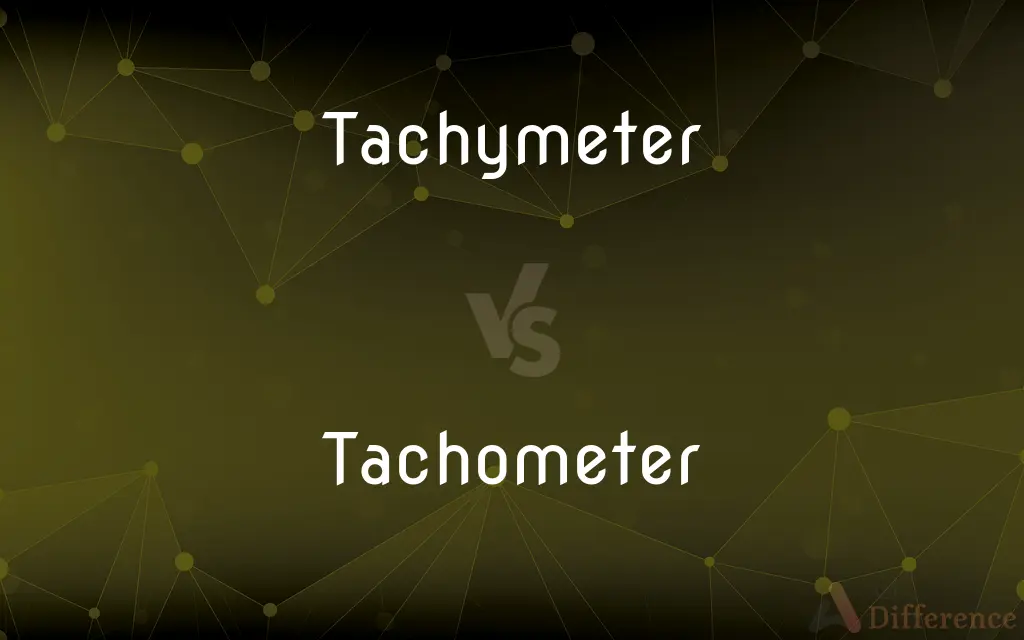Tachymeter vs. Tachometer — What's the Difference?
Edited by Tayyaba Rehman — By Urooj Arif — Updated on March 29, 2024
A tachymeter is a scale on a watch used to measure speed based on travel time, while a tachometer measures the rotation speed of an object in revolutions per minute (RPM).

Difference Between Tachymeter and Tachometer
Table of Contents
ADVERTISEMENT
Key Differences
A tachymeter is a feature commonly found on the bezel of a chronograph watch, allowing the user to compute speed based on travel time or measure distance based on speed. On the other hand, a tachometer is an instrument used in vehicles, machines, and other equipment to measure the rotational speed of an engine or shaft in RPMs. This tool is crucial for monitoring and maintaining optimal operational performance.
Tachymeters are primarily used for quick calculations related to speed and distance and are often featured on sports and racing watches. They require the user to perform a specific action (start and stop) to use the scale for calculations. Tachometers, however, provide continuous monitoring of rotational speed and are essential for the safe and efficient operation of engines, indicating whether the machine is operating within safe or designed limits.
While a tachymeter is a passive tool relying on the user's interaction to provide a single calculation at a time, a tachometer is an active monitoring device that provides real-time data and may be analog or digital. The tachometer's continuous feedback is vital for preventing damage due to excessive speed and ensuring machinery operates within its designed parameters.
The application contexts of these tools are quite different: tachymeters are valued in situations where manual speed or distance calculations are needed quickly without electronic tools, typical in racing or aviation before digital instruments. Tachometers are indispensable in automotive, aviation, industrial, and various mechanical applications where understanding and controlling the rate of rotation is crucial for performance and safety.
Both tachymeters and tachometers deal with the measurement of speed, but they serve distinct purposes, with tachymeters focusing on manual calculations of speed over distance, and tachometers providing continuous measurement of rotational speed.
ADVERTISEMENT
Comparison Chart
Purpose
Measures speed based on time or distance based on speed
Measures rotational speed in RPM
Application
Watches, particularly chronographs
Vehicles, machinery, and equipment
Measurement
Speed in units per hour
Rotations per minute (RPM)
Operation
Manual start and stop to calculate
Continuous monitoring
Primary Use
Speed and distance calculations
Monitoring engine or machinery performance
Display
Scale on watch bezel
Analog or digital display
User Interaction
Requires specific action for calculation
Provides real-time data without user input
Compare with Definitions
Tachymeter
Found on the bezel of chronograph watches.
The tachymeter on his chronograph was instrumental in timing their laps.
Tachometer
Can be found in both analog and digital forms.
The digital tachometer displayed precise RPM readings during the test.
Tachymeter
Can also measure distance based on speed.
The pilot utilized the tachymeter to estimate the distance traveled in a set time.
Tachometer
Provides continuous real-time data.
The tachometer's reading helped adjust the speed for better fuel efficiency.
Tachymeter
Useful in racing and aviation.
Vintage racing enthusiasts often prefer watches with a tachymeter for its historical significance in the sport.
Tachometer
Measures the rotational speed of an object in RPM.
The mechanic checked the engine's performance using the tachometer.
Tachymeter
A scale on a watch used for measuring speed based on time.
He used his watch's tachymeter to calculate their speed during the race.
Tachometer
Essential for monitoring machinery and vehicle engines.
Pilots monitor the aircraft's tachometer to ensure the engines run at optimal speed.
Tachymeter
Requires manual operation for each calculation.
She started and stopped the chronograph at mile markers to calculate speed with the tachymeter.
Tachometer
Critical for safe and efficient operation.
Over-revving detected by the tachometer signaled the need for engine maintenance.
Tachymeter
A surveying instrument used for the rapid determination of distances, elevations, and bearings.
Tachometer
A tachometer (revolution-counter, tach, rev-counter, RPM gauge) is an instrument measuring the rotation speed of a shaft or disk, as in a motor or other machine. The device usually displays the revolutions per minute (RPM) on a calibrated analogue dial, but digital displays are increasingly common.
Tachymeter
A surveying instrument for quickly finding distances.
Tachometer
An instrument which measures the working speed of an engine (especially in a road vehicle), typically in revolutions per minute.
Tachymeter
A speed indicator; a tachometer.
Tachometer
An instrument used to measure the rotations per minute of a rotating shaft.
Tachymeter
An instrument, esp. a transit or theodolite with stadia wires, for determining quickly the distances, bearings, and elevations of distant objects.
Tachometer
A device for measuring the revolutions per minute (RPMs) of a revolving shaft, as with the driveshaft of an automobile.
Tachymeter
A speed indicator; a tachometer.
Tachometer
An instrument for measuring the velocity, or indicating changes in the velocity, of a moving body or substance.
Tachymeter
A theodolite designed for rapid measurements
Tachometer
An instrument for measuring the velocity of running water in a river or canal, consisting of a wheel with inclined vanes, which is turned by the current. The rotations of the wheel are recorded by clockwork.
Tachometer
An instrument for showing at any moment the speed of a revolving shaft, consisting of a delicate revolving conical pendulum which is driven by the shaft, and the action of which by change of speed moves a pointer which indicates the speed on a graduated dial.
Tachometer
Measuring instrument for indicating speed of rotation
Common Curiosities
Where is a tachymeter commonly found?
On the bezel of a chronograph watch.
How does a tachometer work?
It measures the rotational speed of an engine or shaft in RPMs, providing continuous real-time data.
Can a tachymeter replace a tachometer?
No, they serve different purposes; a tachymeter is for manual speed calculations, while a tachometer monitors rotational speed.
How accurate are tachymeters?
They can provide a good estimate of speed or distance but depend on the user's ability to start and stop the measurement accurately.
What is a tachymeter used for?
To measure speed based on travel time or calculate distance based on speed using a scale on a watch.
Why is a tachometer important in vehicles?
It helps ensure the engine operates within safe limits, preventing damage and optimizing performance.
What types of tachometers are there?
Analog and digital, with some modern versions incorporating electronic displays and sensors.
Can I use a tachymeter for any speed?
Tachymeters have a range within which they can accurately calculate speed, typically suited for higher speeds.
How do I read a tachometer?
Read the RPM figure indicated by the needle (in analog) or displayed on the screen (in digital).
How is rotational speed important for machinery?
It's crucial for efficiency and safety, ensuring machinery operates within its designed performance range.
Are tachymeters useful today with modern technology?
Yes, for quick, approximate measurements without the need for electronic devices, especially in sports and recreational activities.
Do all watches with chronographs have tachymeters?
Not all, but it's a common feature on sports and racing watches designed for speed and distance calculations.
What's the difference between a tachymeter and a speedometer?
A tachymeter calculates speed based on time, while a speedometer directly shows the current speed of a vehicle.
Can tachometers measure speed in units other than RPM?
Primarily, tachometers measure RPM, but this can indirectly relate to linear speed depending on the context (e.g., in vehicles).
Is a tachometer necessary for all engines?
While not all engines require a tachometer, it's essential for monitoring and maintenance in many mechanical and automotive applications.
Share Your Discovery

Previous Comparison
Celery vs. Rhubarb
Next Comparison
Castle vs. ChateauAuthor Spotlight
Written by
Urooj ArifUrooj is a skilled content writer at Ask Difference, known for her exceptional ability to simplify complex topics into engaging and informative content. With a passion for research and a flair for clear, concise writing, she consistently delivers articles that resonate with our diverse audience.
Edited by
Tayyaba RehmanTayyaba Rehman is a distinguished writer, currently serving as a primary contributor to askdifference.com. As a researcher in semantics and etymology, Tayyaba's passion for the complexity of languages and their distinctions has found a perfect home on the platform. Tayyaba delves into the intricacies of language, distinguishing between commonly confused words and phrases, thereby providing clarity for readers worldwide.















































